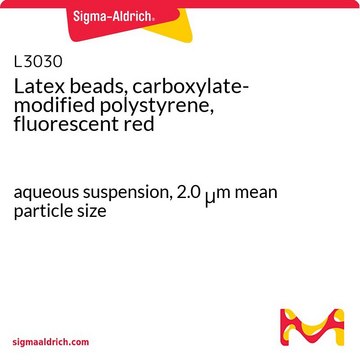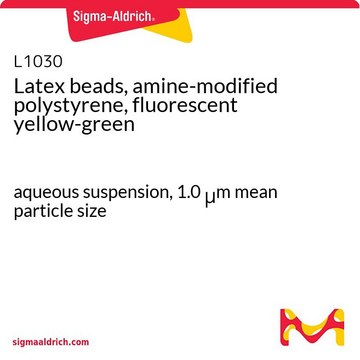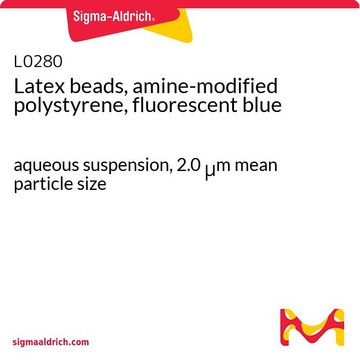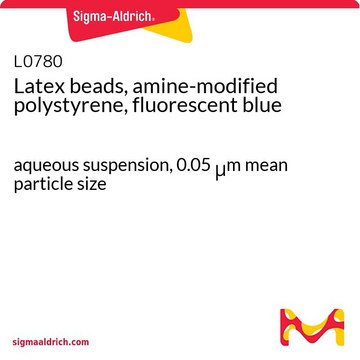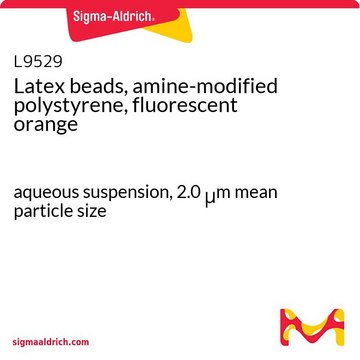L4655
Latex beads, carboxylate-modified polystyrene, fluorescent yellow-green
aqueous suspension, 1.0 μm mean particle size
Synonym(s):
Fluorescent Latex Beads
Sign Into View Organizational & Contract Pricing
All Photos(1)
About This Item
Recommended Products
form
aqueous suspension
composition
Solids, 2.5%
technique(s)
cell based assay: suitable
mean particle size
1.0 μm
fluorescence
λex ~470 nm; λem ~505 nm
suitability
suitable for immunoassay
application(s)
cell analysis
Looking for similar products? Visit Product Comparison Guide
Application
Carboxylate-modified polystyrene latex beads have been used to collect morphofunctional data about the immune systems of Carabus lefebvrei, a helicophagous Italian endemic ground beetle often used as an indicator of the habitat quality of the Apennines mountain forests. Carboxylate-modified polystyrene latex beads have also been used to inform comparative studies on immunity defense mechanisms of adults and larvae of the coleopteran Cetonischema aeruginosa and to investigate the phagocytic activity of cultured rat thyroid cells.
Latex beads, carboxylate-modified polystyrene, fluorescent yellow-green has been used:
- in epidermal growth factor conjugate preparation for indirect immunofluorescence imaging studies
- for culturing mouse bronchoalveolar macrophages and human monocyte-derived macrophages prior to phagocytosis imaging studies
- in coadministration with Salmonella expressed green fluorescent protein (GFP) for confocal microscopy studies and in biofluorescence imaging
Storage Class Code
10 - Combustible liquids
WGK
WGK 3
Flash Point(F)
Not applicable
Flash Point(C)
Not applicable
Certificates of Analysis (COA)
Search for Certificates of Analysis (COA) by entering the products Lot/Batch Number. Lot and Batch Numbers can be found on a product’s label following the words ‘Lot’ or ‘Batch’.
Already Own This Product?
Find documentation for the products that you have recently purchased in the Document Library.
Customers Also Viewed
Bin Fan et al.
Journal of neuroimmunology, 244(1-2), 45-50 (2012-01-21)
Meningothelial cells (MECs) form the innermost layer of the meningeal sheath and as such are in direct contact with the cerebrospinal fluid (CSF) likely influencing CSF composition. The CSF space is a site of active immunological processes. To investigate an
J Ablin et al.
Apoptosis : an international journal on programmed cell death, 10(5), 1009-1018 (2005-09-10)
A number of mechanisms have been proposed to explain the etiology of drug-induced lupus (DIL) but the effect of apoptotic and necrotic cell handling has not been previously examined. To evaluate the effect of quinidine and procainamide at therapeutic range
Elin Silverpil et al.
Inflammation, 34(1), 1-9 (2010-03-27)
There is now substantial evidence that the cytokine interleukin-17 orchestrates the accumulation of neutrophils in mammals and thereby contributes to host defense. However, the role of IL-17 in controlling neutrophil turnover is not fully understood. Here, we demonstrate that IL-17
Libin Huang et al.
Ocular immunology and inflammation, 24(6), 684-692 (2016-12-10)
To evaluate the effect of CX3CL1/CX3CR1 signaling on the interaction between mesenchymal stem cells (MSCs) and retinal microglia. Supernatants of homogenized retina were harvested from light-damaged SD rats (ISHR) to stimulated retinal microglia. Stimulated microglia were cocultured with MSCs, CX3CL1
Micro-shock waves mediated needle-less vaccine delivery
Jagadeesh G, et al.
Clinical Pharmacology Made Incredibly Easy! (2011)
Our team of scientists has experience in all areas of research including Life Science, Material Science, Chemical Synthesis, Chromatography, Analytical and many others.
Contact Technical Service
